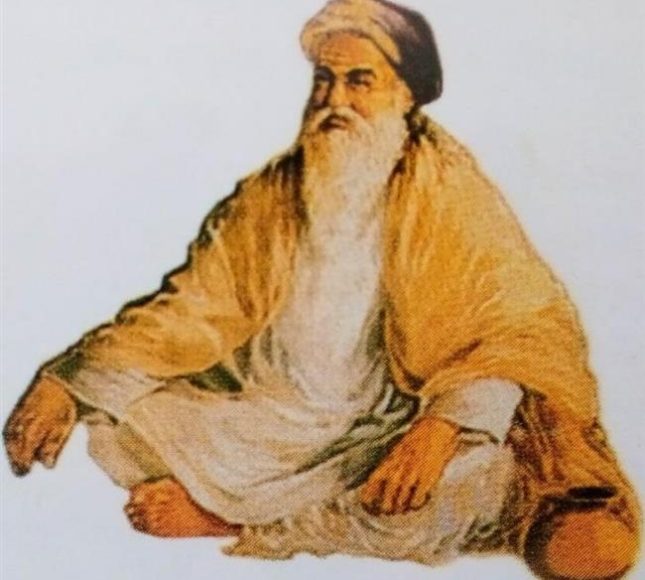Bhagat – Bhagat has roots in the word Bhaj or Bhakt, which means divided (into self and the ‘other’; this ‘other’ may be a god or the Almighty) or sacrificed (into pieces for some god or for the Almighty); hence, a Bhagat is one who is devoted to some god or the Almighty. The word Bhagat has also been traced to the word Bhaj (to adore, honor, love, revere, etc.). It has another root: Bhagvata (devotee of Bhagwan). According to Sikhism, a Bhagat is one who is devoted to the Almighty.
A Sikh is a Bhagat (devotee) of the Almighty only. In Guru Granth Sahib, the non-Guru poets have been mentioned as Bhagats (e.g., Kabir, Ravidas, Ramanand, Namdev, Tirlochan, Parmanand, and Jaidev, etc.). Some of these Bhagats were, in the beginning, the devotees of some Hindu gods, but later, they became devotees of the Almighty only. Sikhism accepted the Bhagti of the Almighty as the real Bhagti, while the rest is considered illusion. The Muslim poet Farid is mentioned as Sheikh, and the bards of the court of Guru Sahib are known as Bhatts.
Bhagats in Sikhism: Voices of Devotion and Spiritual Wisdom
Introduction
In Sikhism, the term Bhagat refers to a holy person or saint who has attained spiritual enlightenment and dedicated their life to devotion and the pursuit of divine truth. Derived from the Sanskrit word Bhakti, meaning devotion or love, Bhagat signifies one who is deeply connected to God through unwavering faith and meditation. The teachings and hymns of several Bhagats are enshrined in the Guru Granth Sahib, the holy scripture of Sikhism, reflecting their universal and timeless wisdom.
The Role of Bhagats in Sikhism
The Bhagats whose compositions are included in the Guru Granth Sahib lived between the 12th and 15th centuries, preceding or contemporaneous with Guru Nanak, the founder of Sikhism. These Bhagats came from diverse religious, social, and cultural backgrounds, including Hinduism and Islam, and their teachings emphasize monotheism, equality, and the rejection of ritualism and caste discrimination. Guru Arjan Dev Ji, the fifth Sikh Guru, compiled their hymns into the Guru Granth Sahib, giving them equal prominence alongside the teachings of the Sikh Gurus.
Key Bhagats and Their Contributions
The Guru Granth Sahib includes the writings of 15 Bhagats, each of whom contributed unique spiritual insights. Some of the prominent Bhagats are:
- Bhagat Kabir Ji: A weaver by profession, Kabir’s hymns emphasize the oneness of God and the futility of rituals. He contributed 292 hymns to the Guru Granth Sahib.
- Bhagat Ravidas Ji: A cobbler by trade, Ravidas advocated for equality and devotion to the formless God. His hymns reflect his deep spiritual wisdom.
- Bhagat Namdev Ji: A calico printer from Maharashtra, Namdev’s hymns highlight the importance of love and devotion to God.
- Baba Farid Ji: A Sufi saint from Punjab, Farid’s compositions focus on humility, self-discipline, and the transient nature of life.
- Bhagat Trilochan Ji: A Brahmin from Maharashtra, Trilochan’s hymns emphasize the importance of meditating on God’s Name.
Each Bhagat’s life and teachings reflect their journey toward spiritual realization and their efforts to inspire humanity to connect with the Divine.
Universal Message of the Bhagats
The Bhagats’ teachings transcend religious boundaries, emphasizing the oneness of God and the equality of all human beings. Their hymns reject idol worship, ritualism, and caste-based discrimination, advocating instead for a direct and personal connection with the Creator. This universal message aligns with the core principles of Sikhism, making their inclusion in the Guru Granth Sahib a testament to the inclusive and egalitarian spirit of the faith.
Conclusion
The Bhagats in Sikhism represent a rich tradition of devotion, wisdom, and spiritual awakening. Their hymns, preserved in the Guru Granth Sahib, continue to inspire Sikhs and seekers of truth worldwide. By emphasizing the oneness of God, the equality of humanity, and the importance of devotion, the Bhagats have left an indelible mark on Sikh philosophy and spirituality.







